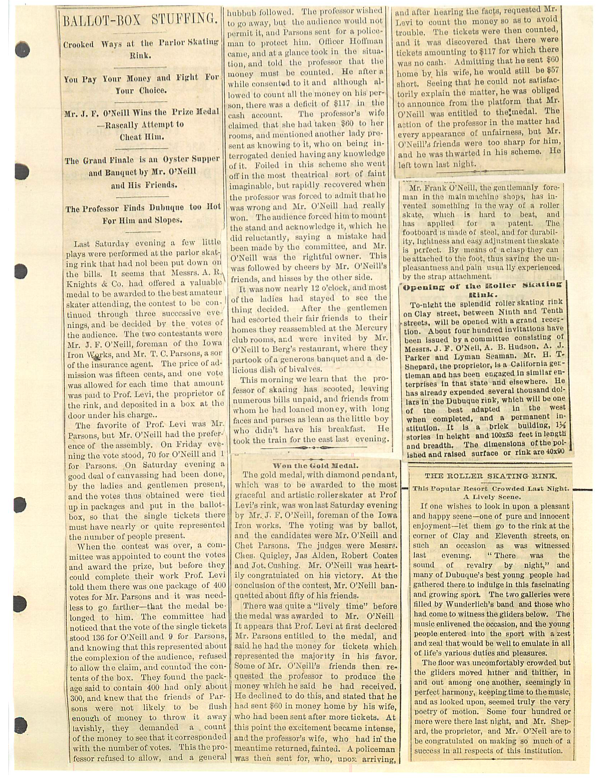Encyclopedia Dubuque
"Encyclopedia Dubuque is the online authority for all things Dubuque, written by the people who know the city best.”
Marshall Cohen—researcher and producer, CNN
Affiliated with the Local History Network of the State Historical Society of Iowa, and the Iowa Museum Association.
ROLLER SKATING
ROLLER SKATING. Roller skating was one of early Dubuque’s most popular recreational activities. On September 7, 1882, Professor Levi, proprietor of skating rinks in Chicago, Memphis and Nashville, demonstrated roller-skating to an invitation-only crowd of Dubuque residents. Levi announced he would also give lessons.
Roller rink development soon followed. A rink was opened between 9th and 10th STREETS on Main soon after the Levi demonstration. On December 22, 1883, another rink was unveiled on Clay Street between Ninth and Tenth to an invitation-only crowd. Located in a brick building, the rink measured 40 feet by 90 feet. (Read: Skating Hi-Jinx) The proprietor, H. T. Shepard, was described as having similar businesses in California and elsewhere. On February 14, 1884, Hyde Clark opened a roller skating rink. Small in comparison to those that followed, the rink measured 50 feet by 114 feet.
Ignoring warnings in 1886 by the Women's Homeopathic Medical Society in Chicago that skating offered more dangers to good health than benefits, skating rinks continued to flourish. The Stearns-Thompson Rink on Couler Avenue boasted galleries from which an estimated two thousand people could watch the skaters. The rink was one of the largest in Dubuque at 50 feet by 150 feet. Four hundred skaters were said to be able to use the hard Michigan maple floor at one time. By 1891 the building was used as a barn for the mules used by Joseph A. RHOMBERG for his streetcars. In March of that year heavy snows cracked the roof beams. (1)
Le Grand rink opened to the public on December 6, 1884. The floor surface measured 110 x 45 fet made of maple. The rink featured a gallery, band stand, cloak and skate room, revolving "programme turned by a crank, and a gong to call attentiion of patrons to the changes occurring on the floor. (2) Perhaps it was the presence of a gallery for viewing the activity of the main floor. In 1888 despite a report of a committee of architects that the building was safe, the owner Al. Clark had an additional twenty iron rods five-eights of an inch thick installed for additional gallery support. (3) In 1889 the centennial ball held by the "ladies of ST. JOHN'S EPISCOPAL CHURCH featured a quartette of men and women and then a drill by young boys in continental costume. A speaker addressing the sacrifices of women during the war of independence and the CIVIL WAR followed by a demonstration of dancing the minuet. The floor was then opened to those in attendance wearing costumes of the colonial period. In 1891 the rink was the scene of a boxing match. Skating was often accompanied by music in the evening.
Among the last rinks to open were those at the Shooting Park in 1906, 6th and Iowa in 1908, and on the Fourth Street extension near the MUNICIPAL ATHLETIC FIELD. So popular did the activity become that citizens petitioned the City Council in September 1915, for the city to construct a rink.
On September 30, 1915, the municipal roller skating rink opened in the converted Flick Box Factory on Seventh Street. Known as the Riverview Roller Rink, the facility had a floor 140 feet by 100 feet. Announcements at the time boasted the rink would also have a gentlemen's smoking room, ladies’ restroom, and ample room for spectators. Lessons were available for beginners and a troupe of expert skaters were scheduled for demonstrations on the afternoons and evenings of October 1, 2, 3, 1915.
Roller skating along city streets came to the attention of the city council in 1936. A representative of the Woman Auxiliary of the Dubuque County Medical Society read a letter from the organization suggesting that "certain improved streets be set aside at certain hours exclusively for roller skating." Members of the recreation commission endorsed the idea and also offered to furnish supervision of the skaters. (4)
In 1942 a rink was located at East 19th Street and Elm.
In 1942 an ordinance was past by the city council concerning the rinks. It stated that before a license could be issued for a rink, 80% of the property owners within 200 feet of the proposed location had to sign a petition approving the license. The rink could only be operated between 2:00 p.m. and 10:30 p.m. and that children under the age of 16 had to leave an hour earlier. Standing around outside the rink was not permitted. (5)
As a post script to the newspaper articles: That 1 carat diamond from the pendant my great-grandfather won (in 1883, I believe) was passed to his daughter, my grandmother. She gave it to my dad who had it made into an engagement ring for my mom in 1946. She left that ring to my eldest son, who gave it to his girlfriend (now wife) in 2006. So after about 135 years later, the story lives on! (6)
---
Source:
1. "Municipal Molecules," Dubuque Daily Herald, March 11, 1891, p. 4
2. "Caught on the Fly," The Daily Herald, December 6, 1884, p. 3
3. "Local News in Brief," The Herald, November 24, 1888, p. 4
4. "Would Protect Roller Skaters," Telegraph-Herald, June 16, 1936, p. 12
5. " Roller Rink Ordinance Adopted," Telegraph Herald, August 16, 1942, p. 9
6. Andrea Wallis Aven, email, November 3, 2018



